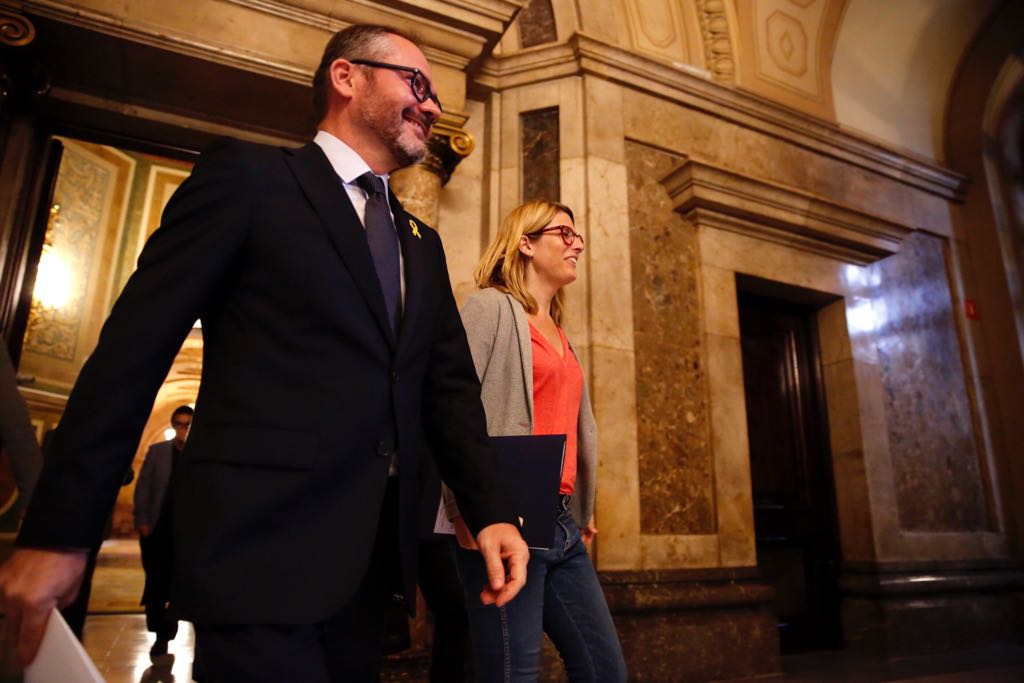The official ceremony for this year's Diada, the Catalan national day, will be used to call for the freedom of the political prisoners and the return of the exiles. This was announced this Monday by the Catalan government spokesperson, Elsa Artadi, and the Parliament's deputy speaker, Josep Costa. The institutional ceremony will take place on 10th September at 8:30pm, with the reception of the Canigó flame at the Parliament. Canigó is a mountain in the Pyrenees. Every year, on the summer solstice, a new fire is lit at its summit, and "flames" from this are then carried around the country.
Although she didn't give more details, Artadi said that her predecessor as presidency minister and government spokesperson, Jordi Turull, took an active part in planning the events for this year's Diada. Turull is currently in pretrial detention in Lledoners prison. "He should be the one here," she said.
The ceremony, directed artistically by Lluís Danés, will start at the Parliament building, in Barcelona's Ciutadella park, with a "light march" headed by president Quim Torra and Parliament speaker Roger Torrent. The parade will end in plaça Sant Jaume, a square with the government palace on one side and Barcelona city hall on the other. On the way, it will stop at El Born Cultural Centre for the formation of the honour guard of Mossos d'Esquadra (the Catalan police), the raising of the senyera (the Catalan flag of four red bars on a yellow background) and the singing of El Cant de la Senyera by the Youth Chorus of the Orfeó Català.
The parade will also symbolise the arrival of light to the government palace after the "darkness" of the months of central government intervention in Catalonia. "Light symbolises the strength and hope of the institutions, aware that we're not all here and that we're only halfway there," the government and parliament say.
The Diada, according to Artadi, will be dedicated to freedom, to "all the freedoms which we feel are threatened and taken away". As an example she cited freedom of expression. The official poster evokes this theme, with the four bars of the Catalan flag covered with duct tape, "symbol of censorship".

Among those expected to take part are artists like Roger Mas, Judit Nedderman (with Txarango) and Núria Graham. This year, texts by Pompeu Fabra, Maria Aurèlia Capmany, Ramon Panikkar and Manuel de Pedrolo are to be read.
Ceremonies at international delegations
The series of official events for this year's Diada will start off on 10th September with the laying of flowers by president Quim Torra at the Fossar de les Moreres at 6pm. The Diada commemorates the fall of Barcelona in 1714 at the end of the War of the Spanish Succession; the Fossar de les Moreres is a memorial square built on a cemetery where those who died defending the city during its siege were buried. At 7pm, the Parliament's Gold Medal will be awarded to the Rosa Sensat Teachers' Association.
Besides the official ceremonies in Catalonia, there will also be the traditional ceremony in the gardens of the Catalan government's delegation to Madrid on Thursday 13th at 7:30pm. According to Artadi, representatives of the Spanish government will be invited. There will also be other ceremonies at the Catalan government's delegations abroad which are fully open, including those to the United Kingdom and Ireland, Brussels and Switzerland.

